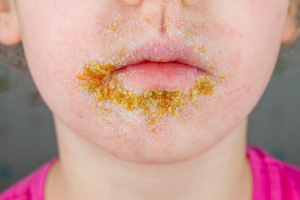Impetigo is a common skin condition in children, particularly those attending schools and daycares, due to close contact. As a parent, it can be distressing to see your little ones in discomfort or experiencing pain. Impetigo in children is a manageable and treatable condition. Dr. Bornstein provides essential information on impetigo in children, including how to recognize and how this skin infection is treated.

DEFINITION:
Infection of the skin
SYMPTOMS:
· Crusting
· Oozing
· Itching
· Swollen glands near the rash
CAUSES:
Streptococcus or staphylococcus bacteria
OUTCOME:
Usually excellent. However, impetigo can sometimes cause complications, including cellulitis (soft tissue infection), osteomyelitis (bone infection), septic arthritis (joint infection), sepsis (bacteria in the bloodstream), or kidney disease, such as post-streptococcal glomerulonephritis, which can be a residual complication from having a strep infection in the past.
CONTAGION:
The incubation period is 2 to 5 days.
Impetigo is contagious until treatment has been ongoing for 24 hours.
TREATMENT AND DISCUSSION:
Impetigo usually begins because a breakage in the skin allows bacteria to penetrate below the skin barrier. This breakage in the skin is usually from trauma (a cut or abrasion), chicken pox, burns, or insect bites. Once the bacteria invade the skin, it spreads, causing crusting, oozing, or itching, which can then spread to other body parts. If it is left untreated, impetigo will typically resolve without complications. The complications that do occur are very rare. Since impetigo is contagious, it is best to treat the child so that it is no longer contagious to other children. Treatment can be with an antibiotic, either orally or topically. The child will be contagious for another 24 hours once they start taking an antibiotic. The antibiotic should be continued for another 7 to 10 days to ensure complete resolution.
ONE DOCTOR’S OPINION:
Impetigo is one of the more common reasons children go to their physicians with a complaint of a rash. According to Nelson’s Textbook of Pediatrics, it accounts for 17% of all visits being for rash. I typically use a topical cream or ointment such as Neosporin or mupirocin (Bactroban), but in worst cases, I will use an oral antibiotic or both. Once the medicine is given, healing occurs rapidly. The contagious period ends after 24 hours of treatment. Still, if the medication is not continued for 7 to 10 days, it can relapse, so be sure to complete the whole course of antibiotic treatment. In recurrent cases, I’ll use Bactroban in the nose for two weeks in addition to regular treatment, as some people carry the bacteria that cause this in their nasal passages.
This blog was written by Dr. Michael Bornstein, who has 30 years of experience as a pediatrician.
Disclaimer: The contents of this article, including text and images, are for informational purposes only and do not constitute a medical service. Please note that all images belong to their original owners. Always seek the advice of a physician or other qualified health professional for medical advice, diagnosis, and treatment.


FOLLOW US